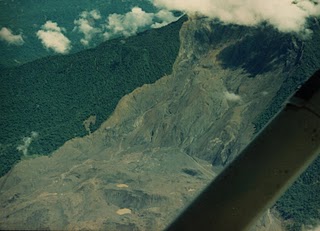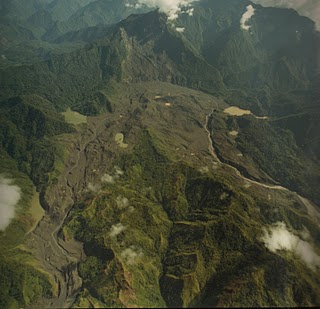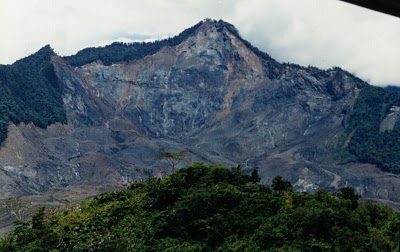25 April 2008
Updated: 25th April: The Kaiapit Landslide, Papua New Guinea, 1988
Posted by Dave Petley
Update: Mark Drechsler has provided some images of the Kaiapit landslide, which are now integrated into the text below. Thanks to Mark for this – it is much appreciated. All images copyright of Mark Drechsler. In addition, I have placed a copy of the Drechsler et al (1989) paper on the International Landslide Centre website here. It provides a fascinating level of detail about the slide. I recommend this paper over and above the alternative.
Original text: Thanks for Mark Drechsler of Parsons Brinkerhoff Australia and the University of Adelaide for reminding me of the Kaiapit Landslide, which is surely one of the largest landslides of the last two decades (can anyone think of any larger?). Even though its impact was not enormous (74 deaths in three villages) the scale of this landslide is staggering. The landslide was described in a paper by Dreschler et al. (1989) and one by Peart (1991), from which these details are taken.
 The slope failed at 10:43 am on 6th September 1988 when approximately 1.8 cubic kilometres of mountian collapsed, leaving a scar 1600 m high. The debris ran out over a distance of 6.5 km, covering an area of over 11 square kilometres. The estimated velocity is up to 180 km/hour. The slide inundated three villages and formed four valley-blockage lakes.
The slope failed at 10:43 am on 6th September 1988 when approximately 1.8 cubic kilometres of mountian collapsed, leaving a scar 1600 m high. The debris ran out over a distance of 6.5 km, covering an area of over 11 square kilometres. The estimated velocity is up to 180 km/hour. The slide inundated three villages and formed four valley-blockage lakes.
What is particularly interesting about this slide is the lack of an obvious trigger. Peart (1991) reported that the time of initiation was not the rainy season (indeed it was towards the end of the dry season) and that the period in question was not particularly wet. No seismic activity was recorded. The area has not been glaciated, so over-steepening and loss of support cannot be a cause. Clearly the area is affected by high levels of uplift, which may have allowed the formation of over-steepened slopes. These are probably a causal factor, but do not explain the triggering.
Peart (1991) sagely suggested that there may have been a time-related factor in the initiation of the landslide. I am convinced that time-dependent behaviour is important for large-scale landslide triggering, which means that the time of failure might lag significantly behind the trigger event. This is not always the case, but quite often very large landslides do not have an obvious trigger event. Other examples include the Mount Cook failure in New Zealand and the Leyte landslide in the Philippines.
 Sadly the Google Earth imagery of the slide site is covered by clouds. Comments are welcome as ever.
Sadly the Google Earth imagery of the slide site is covered by clouds. Comments are welcome as ever.
Reference
Drechsler, M. Ripper, I., Rooke, E. and Warren, E. 1989. The Kaiapit Landslide, Papua New Guinea. In: Engineering Geology in Tropical Terrains, Universiti Kebaangsan Malaysia.
Peart, M. 1991. The Kaiapit landslide: events and mechanisms. Quarterly Journal of Engineering Geology, 24, 399-411.
Hat-tip: Mark Drechsler from Parsons Brinckerhoff and University of Adelaide.



 Dave Petley is the Vice-Chancellor of the University of Hull in the United Kingdom. His blog provides commentary and analysis of landslide events occurring worldwide, including the landslides themselves, latest research, and conferences and meetings.
Dave Petley is the Vice-Chancellor of the University of Hull in the United Kingdom. His blog provides commentary and analysis of landslide events occurring worldwide, including the landslides themselves, latest research, and conferences and meetings.
Dave,Many thnaks for including the Kaiapit Landslide on your blog. Can you correct the spelling of my name to Mark Drechsler and also the company name to Parsons Brinckerhoff.Can you also reference my paper of 1989 which was largely copied by M Peart for his paper of 1991 (a sore point in history!!!).I will send you a DVD by mail with aerial photographs, video, powrpoint presentation and copies of papers.RegardsMark Drechsler, Adelaide Australia.
Thanks to Dave for posting this information. My parents and I were (from Marafau Village; one of the affected villages of three)the victims of the Landslide when I was 1 year old. Now I’m doing final year at UPNG and I’m resaerching information on the landslide to do a major project on Hazard and Risk Management Course. Thank you very much…
Hi Dave,I am a civil engineering student doing an assignment on the Kaiapit Landslide. Was just wondering if the photos sent from Mark Drechsler of the area are posted up anywhere?Thanks,Ryan [email protected]
Thanks to Mark for his comments – I have amended the page as requested. Ryan – I have now added the photos and have linked to Mark’s paper. I hope that this provides what you need.D.
That’s great. Thanks for your help
Funny enough, its 2020, it’s a Sunday morning. My thoughts traveled back to my childhood at my grandfather’s village of Arifiran and the view of my bubus house towards the mountain came to mind. I googled the “Kaiapit Landslide and hoping theres something in the web to read about and came across this. Thank you for this. I enjoyed the village myths and that came with this landslide and it’s good to read the science behind it